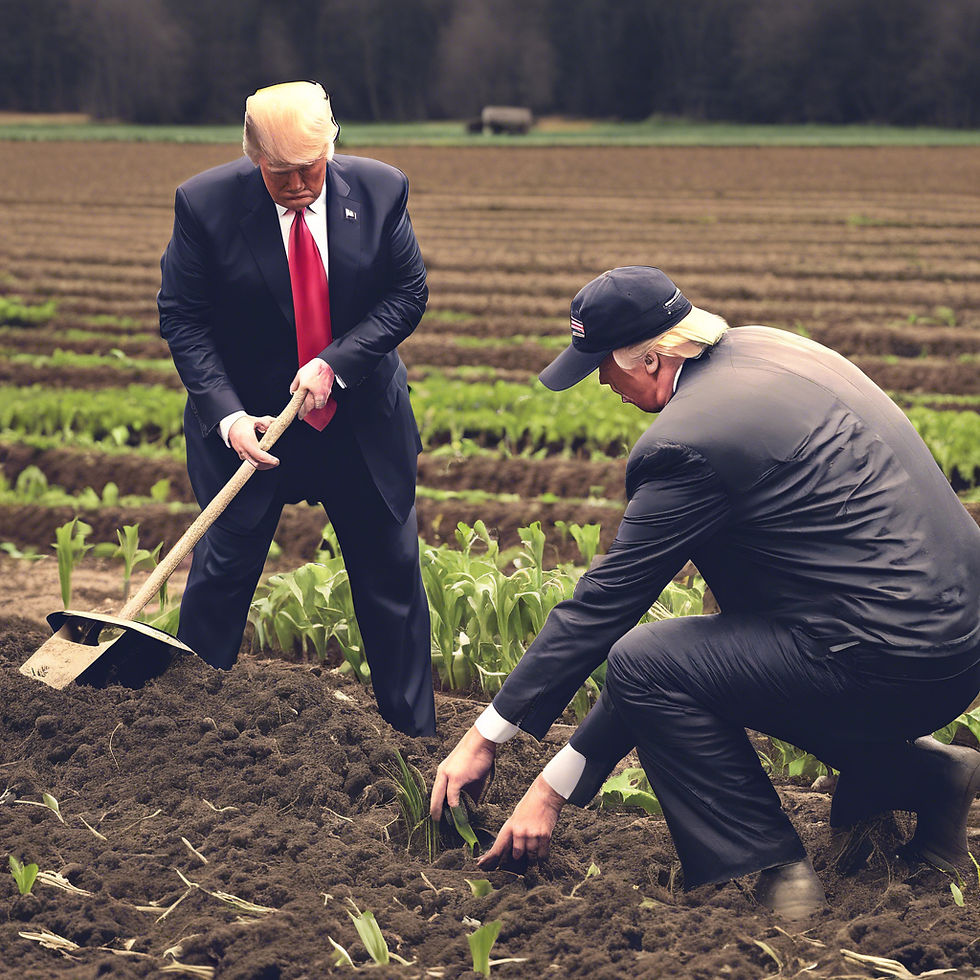🌍 Will We Run Out of Food by 2050?
- Malik Miller

- Mar 31
- 4 min read
And What Does It Actually Take to Feed Every Person in America?
In an age where climate change dominates headlines and global population projections continue to rise, the future of food is a pressing concern. A commonly circulated myth says that by 2050, we’ll “run out of food.”Let’s unpack the truth behind this claim, explore the realities of feeding over 330 million Americans every single day, and examine the challenges—and solutions—that lie ahead for global agriculture.
🇺🇸 How Much Food Does It Take to Feed America?
The United States is a global agricultural powerhouse. It produces more food than any other country on Earth except China and India—and exports millions of tons globally each year. But how much does it take just to feed us?
✅ Basic Facts:
Population: Over 330 million people (as of 2024)
Daily caloric needs (average adult): ~2,000–2,500 calories/day
Calories produced per person per day (USDA): ~3,800 calories
Even after accounting for exports and animal feed, there is more than enough to meet national dietary requirements. So what's the problem?
🗑 The Food Waste Factor:
Roughly 30–40% of the U.S. food supply is lost or wasted.
On farms (due to damage or market rejection)
In transport and retail (spoilage, expiration)
At home (leftovers, over-purchasing, aesthetic preferences)
This equates to over 130 billion pounds of food wasted annually.
If waste were cut in half, it could feed millions of additional people—without planting a single extra acre.
💸 Where Does the Money Go?
The total annual U.S. food expenditure exceeds $2.3 trillion, but the farmer's portion is shockingly low:
For every $1 spent on food, just $0.076 (7.6 cents) goes to the farmer.
The rest goes to transportation, processing, packaging, marketing, distribution, and retail markup.
Farmers are feeding the nation, but their profit margin is razor-thin—and often reliant on subsidies, scale, and market access.
🌎 Will the World Run Out of Food by 2050?
Let’s tackle this myth directly:No, we are not likely to “run out” of food by 2050.But we are heading toward a critical inflection point that could cause localized food shortages, economic instability, and rising food insecurity—especially in vulnerable regions.
🌐 The Global Challenge:
World population projection (2050): 9.7 billion people
Required increase in food production: 60% to 70% more than today
Available farmland: Mostly maxed out—expansion leads to deforestation and biodiversity loss
Climate stressors: More frequent droughts, floods, temperature extremes, and shifting growing zones
The question isn't "Will we have food?" but rather:
Can we grow it sustainably, distribute it equitably, and make it affordable for everyone?
🧩 What Are the Real Threats to the Global Food System?
🔥 1. Climate Change
Warmer temperatures are already reducing yields of wheat, corn, and rice.
Unpredictable weather disrupts planting and harvest schedules.
Pest and disease ranges are expanding.
💧 2. Water Scarcity
Agriculture uses 70% of the world’s freshwater.
Aquifers are being depleted faster than they can replenish.
Many regions face "water stress" that could limit future food production.
🌱 3. Soil Degradation
Roughly 33% of global soils are already degraded.
Tillage, monocropping, and chemical use can accelerate erosion and reduce fertility.
👨🌾 4. Labor Shortages
Aging farmers and declining interest in farm labor create bottlenecks in production.
Immigration restrictions and urbanization worsen labor access.
💰 5. Economic Access
The real food crisis often isn't production—it’s poverty.
Millions go hungry not because there isn’t food, but because they can’t afford it or it’s not accessible where they live.
💡 So, What Are the Solutions?
✅ The Good News:
We already have the knowledge, tools, and technologies to meet 2050’s food needs—we just need to apply them wisely and equitably.
🔧 Modern Agriculture is Innovating Fast:
Precision agriculture: GPS-guided tractors, drones, soil sensors, and data analytics reduce input waste and boost yields.
Vertical farming: Growing food in stacked systems indoors using 90% less water.
Regenerative practices: Restoring soil health through no-till, cover crops, managed grazing, and composting.
Alternative proteins: Plant-based meats, insect proteins, and lab-grown meat could relieve pressure on land and water.
Better storage & logistics: Reducing post-harvest losses, especially in developing regions.
Policy shifts: Supporting local food systems, improving land rights, investing in ag education and research.
🔄 What Can We Do—As Farmers, Consumers, and Advocates?
If you’re a farmer:
Adopt climate-smart practices.
Monitor soil health and water use.
Diversify your crops and income streams.
If you’re a consumer:
Support local agriculture and food producers.
Reduce food waste at home.
Educate yourself about how food is grown and priced.
If you're an advocate or policymaker:
Push for funding in sustainable ag and ag tech.
Protect farmland from development.
Promote equitable food systems and access.
🧠 Final Thoughts
No, we’re not "running out" of food—but feeding the world by 2050 will require deep transformation. We’ll need to grow smarter, waste less, and work together across borders, sectors, and ideologies.
The real question isn’t can we feed the world?It’s will we choose to do it sustainably, justly, and intelligently?
Because food security is not just about farming—it’s about the future of civilization itself.






Comments